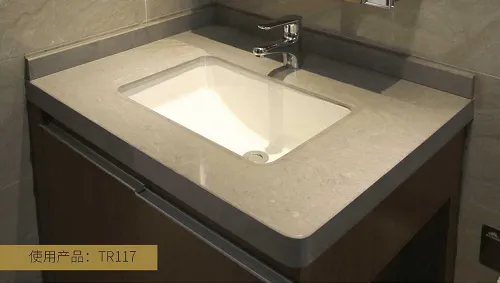In recent years, artificial stone has gradually become a popular choice for home decoration due to its advantages such as beauty, durability and easy cleaning. However, with the enhancement of environmental protection and health awareness, more and more consumers have begun to pay attention to whether the manufacturing process of artificial stone is toxic and whether it has potential harm to human health and the environment.
This article will discuss in detail the manufacturing process of artificial stone, the toxic substances that may be involved and their impact on health and the environment, aiming to provide consumers with comprehensive information.
★ Definition and manufacturing process of artificial stone
Artificial stone, usually including quartz stone, acrylic stone, composite stone, etc., is a synthetic material made by combining natural stone chips with resin through high temperature and high pressure process. Its manufacturing process can be roughly divided into the following steps:
1. Raw material preparation: preparation of raw materials such as natural stone chips, resin, pigment, etc.
2. Mixing and stirring: Mix natural stone chips with resin and pigment in a certain proportion and stir evenly.
3. Mold molding: Pour the mixed material into the mold and mold it by high temperature and high pressure.
4. Curing and cooling: The formed material needs to be cured and cooled to ensure the stability and hardness of its structure.
5. Cutting and polishing: The cured material is cut, polished and processed to make plates or finished products of various specifications and shapes.

★ Potentially toxic substances in the manufacturing process
In the above manufacturing process, the main materials and processes involved may contain potential toxic substances, mainly including the following categories:
① Resin
Resin is the main adhesive of artificial stone. Commonly used resins include polyester resin, epoxy resin, etc. These resins may release volatile organic compounds (VOCs), such as styrene and formaldehyde, during production and use. These chemicals are volatile and may cause harm to human health, such as respiratory irritation, headache, nausea, etc., if exposed to high concentrations for a long time.
② Pigments
The color and pattern of artificial stone are mainly achieved by adding pigments. Some pigments contain heavy metal elements, such as lead and cadmium. If they are not handled properly during the production process, these heavy metals may pollute the environment and pose a threat to human health.
③ Dust during processing
A large amount of stone dust will be generated during the cutting and polishing process. If these dusts contain quartz and other components, they may cause lung diseases such as silicosis after being inhaled by the human body. This disease is more common in workers who are exposed to high concentrations of quartz dust for a long time.
★ Environmental protection and health risk assessment
① Impact on human health
Although artificial stone itself is relatively safe during use, if effective protective measures are not taken during the manufacturing and processing process, it may have a certain impact on the health of workers. For example, workers who are exposed to high concentrations of VOCs and stone dust for a long time have a higher risk of occupational diseases. Therefore, relevant factories should strictly abide by safety production standards and provide necessary protective equipment, such as dust masks, ventilation equipment, etc.
② Impact on the environment
Waste, wastewater, waste gas, etc. generated during the manufacturing process of artificial stone may pollute the surrounding environment if not properly treated. For example, untreated wastewater may contain resin residues and heavy metals, which will pollute water and soil when discharged into the natural environment. Therefore, the factory needs to establish a complete environmental protection treatment system to ensure that the waste is discharged in compliance with standards.

★ Environmental protection measures in the industry
With the improvement of environmental awareness, many manufacturing companies have begun to take measures to reduce toxic substances and pollution emissions in the manufacturing process. For example:
1. Use of low-VOC resins: Select low-VOC or even VOC-free resin materials to reduce the release of harmful gases.
2. Environmentally friendly pigments: Use lead-free, cadmium-free and other environmentally friendly pigments to avoid heavy metal pollution.
3. Dust control: Install high-efficiency dust collection equipment in cutting, polishing and other links to reduce dust emissions and protect workers' health.
4. Wastewater treatment: Establish an advanced wastewater treatment system to treat wastewater generated during the production process to ensure that emissions meet standards.
★ How consumers choose safe artificial stone products
As consumers, choosing safe and environmentally friendly artificial stone products can start from the following aspects:
1. Certification marks: Choose products with environmental certification marks, such as ISO14001 Environmental Management System Certification, China Environmental Label Certification, etc. These certification marks indicate that the product follows strict environmental standards during the production process.
2. Brand reputation: Choose well-known brands or manufacturers with good reputations, and their product quality and environmental performance are more guaranteed.
3. Product test report: Ask the merchant for the product test report, understand the product's VOCs, heavy metal content and other indicators, and ensure that it meets the relevant standards.
4. After-sales service: Understand the after-sales service of the product, choose a merchant that provides perfect after-sales guarantee, and ensure that problems encountered during the use of the product can be solved in time.
Conclusion
As a new type of building material, artificial stone is increasingly used in home decoration. Although its manufacturing process may involve some toxic substances, as long as the manufacturer strictly abides by the environmental protection and production safety standards and takes effective protection and pollution control measures, the impact of artificial stone on human health and the environment can be controlled within a safe range.
When choosing artificial stone products, consumers should also pay attention to environmental protection and health, choose regular brands and products with environmental protection certification to ensure the safety and health of the home environment.

